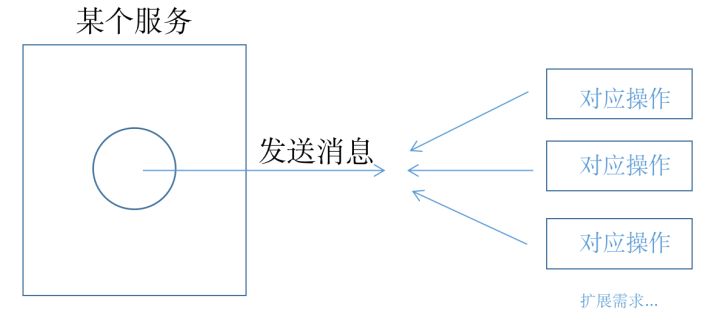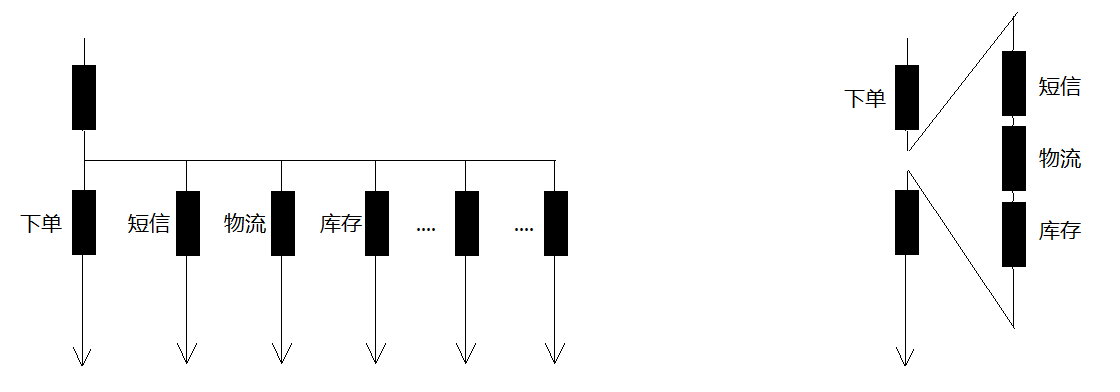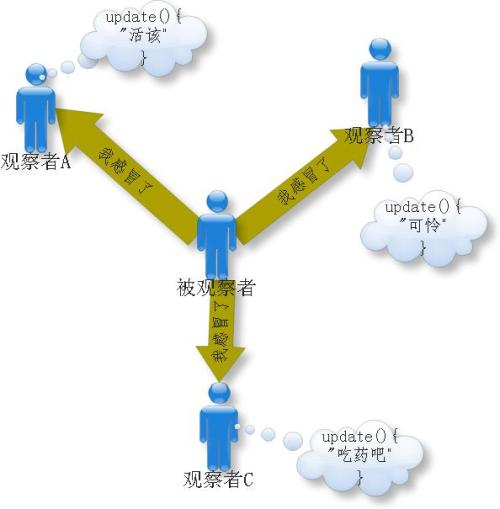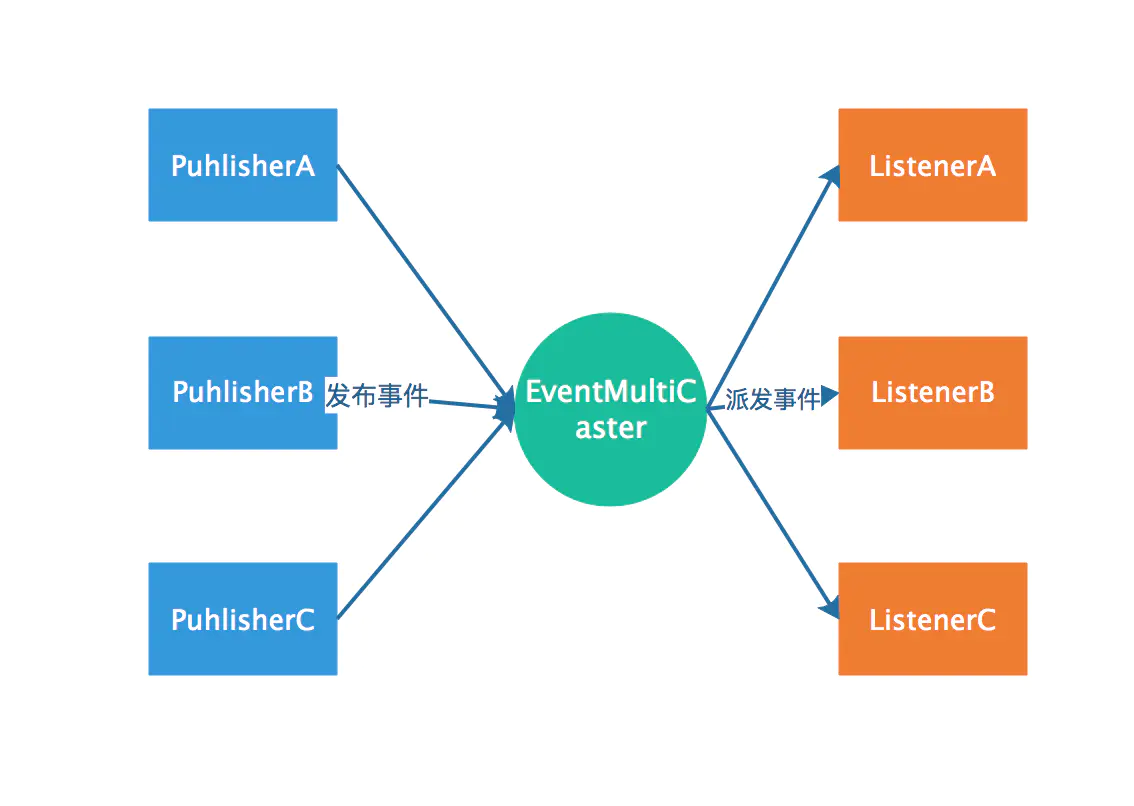Spring事件监听机制
目录
1. 使用Spring 事件
Spring事件体系包括三个组件:事件,事件监听器,事件广播器。
事件
Spring内置事件
内置事件中由系统内部进行发布,只需注入监听器

| Event | 说明 |
| ContextRefreshedEvent | 当容器被实例化或refreshed时发布.如调用refresh()方法, 此处的实例化是指所有的bean都已被加载,后置处理器都被激活,所有单例bean都已被实例化, 所有的容器对象都已准备好可使用. 如果容器支持热重载,则refresh可以被触发多次(XmlWebApplicatonContext支持热刷新,而GenericApplicationContext则不支持) |
| ContextStartedEvent | 当容器启动时发布,即调用start()方法, 已启用意味着所有的Lifecycle bean都已显式接收到了start信号 |
| ContextStoppedEvent | 当容器停止时发布,即调用stop()方法, 即所有的Lifecycle bean都已显式接收到了stop信号 , 关闭的容器可以通过start()方法重启 |
| ContextClosedEvent | 当容器关闭时发布,即调用close方法, 关闭意味着所有的单例bean都已被销毁.关闭的容器不能被重启或refresh |
| RequestHandledEvent | 这只在使用spring的DispatcherServlet时有效,当一个请求被处理完成时发布 |
自定义事件
事件类需要继承ApplicationEvent,代码如下:
public class BigEvent extends ApplicationEvent {
private String name;
public BigEvent(Object source, String name) {
super(source);
this.name = name;
}
public String getName() {
return name;
}
}这里为了简单测试,所以写的很简单。
事件类是一种很简单的pojo,除了需要继承ApplicationEvent也没什么了,这个类有一个构造方法需要super。
事件监听器
事件监听器-基于接口
@Component
public?class?HelloEventListener?implements?ApplicationListener<OrderEvent> {
?
????@Override
????public?void?onApplicationEvent(OrderEvent event) {
if(event.getName().equals("减库存")){
System.out.println("减库存.......");
}
????}
}????????事件监听器需要实现ApplicationListener接口,这是个泛型接口,泛型类类型就是事件类型,其次需要是spring容器托管的bean,所以这里加了@component,只有一个方法,就是onApplicationEvent。
事件监听器-基于注解
@Component
public class OrderEventListener {
@EventListener(OrderEvent.class)
public void onApplicationEvent(OrderEvent event) {
if(event.getName().equals("减库存")){
System.out.println("减库存.......");
}
}
}事件发布操作
事件发布方式很简单
applicationContext.publishEvent(new?HelloEvent(this,"zs"));然后调用方法就能看到
2023-12-22?19:08:00.052??INFO?284928?--- [nio-5577-exec-3] l.b.e.c.s.event.HelloEventListener?????? : receive zs say hello!

疑问
- 同样的事件能有多个监听器 -- 可以的
- 事件监听器一定要写一个类去实现吗 -- 其实是可以不需要的,spring有个注解@EventListener,修饰在方法上,稍后给出使用方法
- 事件监听操作和发布事件的操作是同步的吗? -- 是的,所以如果有事务,监听操作也在事务内
- 可以作为异步处理吗? --可以 看源码有解释。:
@Bean(name = "applicationEventMulticaster")
public ApplicationEventMulticaster simpleApplicationEventMulticaster() {
SimpleApplicationEventMulticaster eventMulticaster
= new SimpleApplicationEventMulticaster();
eventMulticaster.setTaskExecutor(new SimpleAsyncTaskExecutor());
return eventMulticaster;
}
2. Spring事件原理
原理:观察者模式
spring的事件监听有三个部分组成:
- 事件(ApplicationEvent) 负责对应相应监听器 事件源发生某事件是特定事件监听器被触发的原因。
- 监听器(ApplicationListener) 对应于观察者模式中的观察者。监听器监听特定事件,并在内部定义了事件发生后的响应逻辑。
- 事件发布器(ApplicationEventMulticaster )对应于观察者模式中的被观察者/主题, 负责通知观察者 对外提供发布事件和增删事件监听器的接口,维护事件和事件监听器之间的映射关系,并在事件发生时负责通知相关监听器。

????????Spring事件机制是观察者模式的一种实现,但是除了发布者和监听者者两个角色之外,还有一个EventMultiCaster的角色负责把事件转发给监听者,工作流程如下:

Spring事件机制
????????也就是说上面代码中发布者调用applicationEventPublisher.publishEvent(msg); 是会将事件发送给了EventMultiCaster, 而后由EventMultiCaster注册着所有的Listener,然后根据事件类型决定转发给那个Listener。
源码流程

Spring在ApplicationContext接口的抽象实现类AbstractApplicationContext中完成了事件体系的搭建。
AbstractApplicationContext拥有一个applicationEventMulticaster成员变量,applicationEventMulticaster提供了容器监听器的注册表。
AbstractApplicationContext在refresh()这个容器启动方法中搭建了事件的基础设施,其中AbstractApplicationContext的refresh方法实现如下:
@Override
public void refresh() throws BeansException, IllegalStateException {
synchronized (this.startupShutdownMonitor) {
// Prepare this context for refreshing.
prepareRefresh();
// Tell the subclass to refresh the internal bean factory.
ConfigurableListableBeanFactory beanFactory = obtainFreshBeanFactory();
// Prepare the bean factory for use in this context.
prepareBeanFactory(beanFactory);
try {
// Allows post-processing of the bean factory in context subclasses.
postProcessBeanFactory(beanFactory);
// Invoke factory processors registered as beans in the context.
invokeBeanFactoryPostProcessors(beanFactory);
// Register bean processors that intercept bean creation.
registerBeanPostProcessors(beanFactory);
// Initialize message source for this context.
initMessageSource();
// Initialize event multicaster for this context.
initApplicationEventMulticaster();
// Initialize other special beans in specific context subclasses.
onRefresh();
// Check for listener beans and register them.
registerListeners();
// Instantiate all remaining (non-lazy-init) singletons.
finishBeanFactoryInitialization(beanFactory);
// Last step: publish corresponding event.
finishRefresh();
}
catch (BeansException ex) {
if (logger.isWarnEnabled()) {
logger.warn("Exception encountered during context initialization - " +
"cancelling refresh attempt: " + ex);
}
// Destroy already created singletons to avoid dangling resources.
destroyBeans();
// Reset 'active' flag.
cancelRefresh(ex);
// Propagate exception to caller.
throw ex;
}
finally {
// Reset common introspection caches in Spring's core, since we
// might not ever need metadata for singleton beans anymore...
resetCommonCaches();
}
}
}1 事件广播器的初始化
/**
* Initialize the ApplicationEventMulticaster.
* Uses SimpleApplicationEventMulticaster if none defined in the context.
* @see org.springframework.context.event.SimpleApplicationEventMulticaster
*/
protected void initApplicationEventMulticaster() {
ConfigurableListableBeanFactory beanFactory = getBeanFactory();
if (beanFactory.containsLocalBean(APPLICATION_EVENT_MULTICASTER_BEAN_NAME)) {
this.applicationEventMulticaster =
beanFactory.getBean(APPLICATION_EVENT_MULTICASTER_BEAN_NAME, ApplicationEventMulticaster.class);
if (logger.isDebugEnabled()) {
logger.debug("Using ApplicationEventMulticaster [" + this.applicationEventMulticaster + "]");
}
}
else {
this.applicationEventMulticaster = new SimpleApplicationEventMulticaster(beanFactory);
beanFactory.registerSingleton(APPLICATION_EVENT_MULTICASTER_BEAN_NAME, this.applicationEventMulticaster);
if (logger.isDebugEnabled()) {
logger.debug("Unable to locate ApplicationEventMulticaster with name '" +
APPLICATION_EVENT_MULTICASTER_BEAN_NAME +
"': using default [" + this.applicationEventMulticaster + "]");
}
}
}????????事件广播器,只要实现ApplicationEventMulticaster就可以了,Spring会通过 反射的机制将其注册成容器的事件广播器,如果没有找到配置的外部事件广播器,Spring自动使用 SimpleApplicationEventMulticaster作为事件广播器。
2 注册事件监听器
/**
* Add beans that implement ApplicationListener as listeners.
* Doesn't affect other listeners, which can be added without being beans.
*/
protected void registerListeners() {
// Register statically specified listeners first.
for (ApplicationListener<?> listener : getApplicationListeners()) {
getApplicationEventMulticaster().addApplicationListener(listener);
}
// Do not initialize FactoryBeans here: We need to leave all regular beans
// uninitialized to let post-processors apply to them!
String[] listenerBeanNames = getBeanNamesForType(ApplicationListener.class, true, false);
for (String listenerBeanName : listenerBeanNames) {
getApplicationEventMulticaster().addApplicationListenerBean(listenerBeanName);
}
// Publish early application events now that we finally have a multicaster...
Set<ApplicationEvent> earlyEventsToProcess = this.earlyApplicationEvents;
this.earlyApplicationEvents = null;
if (earlyEventsToProcess != null) {
for (ApplicationEvent earlyEvent : earlyEventsToProcess) {
getApplicationEventMulticaster().multicastEvent(earlyEvent);
}
}
}????????Spring根据反射机制,使用ListableBeanFactory的getBeansOfType方法,从BeanDefinitionRegistry中找出所有实现 org.springframework.context.ApplicationListener的Bean,将它们注册为容器的事件监听器,实际的操作就是将其添加到事件广播器所提供的监听器注册表中。
3 发布事件
跟着 finishRefresh();方法进入publishEvent(new ContextRefreshedEvent(this));方法如下:
/**
* Publish the given event to all listeners.
* @param event the event to publish (may be an {@link ApplicationEvent}
* or a payload object to be turned into a {@link PayloadApplicationEvent})
* @param eventType the resolved event type, if known
* @since 4.2
*/
protected void publishEvent(Object event, ResolvableType eventType) {
Assert.notNull(event, "Event must not be null");
if (logger.isTraceEnabled()) {
logger.trace("Publishing event in " + getDisplayName() + ": " + event);
}
// Decorate event as an ApplicationEvent if necessary
ApplicationEvent applicationEvent;
if (event instanceof ApplicationEvent) {
applicationEvent = (ApplicationEvent) event;
}
else {
applicationEvent = new PayloadApplicationEvent<Object>(this, event);
if (eventType == null) {
eventType = ((PayloadApplicationEvent)applicationEvent).getResolvableType();
}
}
// Multicast right now if possible - or lazily once the multicaster is initialized
if (this.earlyApplicationEvents != null) {
this.earlyApplicationEvents.add(applicationEvent);
}
else {
getApplicationEventMulticaster().multicastEvent(applicationEvent, eventType);
}
// Publish event via parent context as well...
if (this.parent != null) {
if (this.parent instanceof AbstractApplicationContext) {
((AbstractApplicationContext) this.parent).publishEvent(event, eventType);
}
else {
this.parent.publishEvent(event);
}
}
}????????在AbstractApplicationContext的publishEvent方法中, Spring委托ApplicationEventMulticaster将事件通知给所有的事件监听器.
4 Spring默认的事件广播器SimpleApplicationEventMulticaster
@Override
public void multicastEvent(final ApplicationEvent event, ResolvableType eventType) {
ResolvableType type = (eventType != null ? eventType : resolveDefaultEventType(event));
for (final ApplicationListener<?> listener : getApplicationListeners(event, type)) {
Executor executor = getTaskExecutor();
if (executor != null) {
executor.execute(new Runnable() {
@Override
public void run() {
invokeListener(listener, event);
}
});
}
else {
invokeListener(listener, event);
}
}
}
/**
* Invoke the given listener with the given event.
* @param listener the ApplicationListener to invoke
* @param event the current event to propagate
* @since 4.1
*/
@SuppressWarnings({"unchecked", "rawtypes"})
protected void invokeListener(ApplicationListener listener, ApplicationEvent event) {
ErrorHandler errorHandler = getErrorHandler();
if (errorHandler != null) {
try {
listener.onApplicationEvent(event);
}
catch (Throwable err) {
errorHandler.handleError(err);
}
}
else {
try {
listener.onApplicationEvent(event);
}
catch (ClassCastException ex) {
// Possibly a lambda-defined listener which we could not resolve the generic event type for
LogFactory.getLog(getClass()).debug("Non-matching event type for listener: " + listener, ex);
}
}
}????????遍历注册的每个监听器,并启动来调用每个监听器的onApplicationEvent方法。由于SimpleApplicationEventMulticaster的taskExecutor的实现类是SyncTaskExecutor,因此,事件监听器对事件的处理,是同步进行的。
????????从代码可以看出,applicationContext.publishEvent()方法,需要同步等待各个监听器处理完之后,才返回。
????????也就是说,Spring提供的事件机制,默认是同步的。如果想用异步的,可以自己实现ApplicationEventMulticaster接口,并在Spring容器中注册id为applicationEventMulticaster的Bean。例如下面所示:
public class AsyncApplicationEventMulticaster extends AbstractApplicationEventMulticaster {
private TaskExecutor taskExecutor = new SimpleAsyncTaskExecutor();
public void setTaskExecutor(TaskExecutor taskExecutor) {
this.taskExecutor = (taskExecutor != null ? taskExecutor : new SimpleAsyncTaskExecutor());
}
protected TaskExecutor getTaskExecutor() {
return this.taskExecutor;
}
@SuppressWarnings("unchecked")
public void multicastEvent(final ApplicationEvent event) {
for (Iterator<ApplicationListener> it = getApplicationListeners().iterator(); it.hasNext();) {
final ApplicationListener listener = it.next();
getTaskExecutor().execute(new Runnable() {
public void run() {
listener.onApplicationEvent(event);
}
});
}
}
} spring配置:
@Bean(name = "applicationEventMulticaster")
public ApplicationEventMulticaster simpleApplicationEventMulticaster() {
SimpleApplicationEventMulticaster eventMulticaster
= new SimpleApplicationEventMulticaster();
//ThreadPoolTaskExecutor
eventMulticaster.setTaskExecutor(new SimpleAsyncTaskExecutor());
return eventMulticaster;
}????????Spring发布事件之后,所有注册的事件监听器,都会收到该事件,因此,事件监听器在处理事件时,需要先判断该事件是否是自己关心的。
????????Sping事件体系所使用的设计模式是:观察者模式。ApplicationListener是观察者接口,接口中定义了onApplicationEvent方法,该方法的作用是对ApplicationEvent事件进行处理。
问题
- Spring是怎样避免读取到不完整Bean的?
- 怎么样可以在所有Bean创建完后做扩展代码?
- 请介绍下Spring事件监听器的原理。
本文来自互联网用户投稿,该文观点仅代表作者本人,不代表本站立场。本站仅提供信息存储空间服务,不拥有所有权,不承担相关法律责任。 如若内容造成侵权/违法违规/事实不符,请联系我的编程经验分享网邮箱:veading@qq.com进行投诉反馈,一经查实,立即删除!